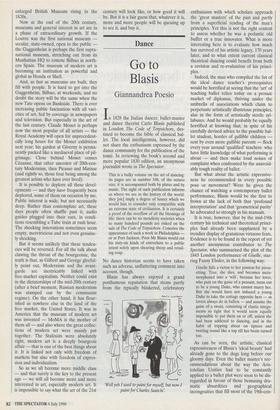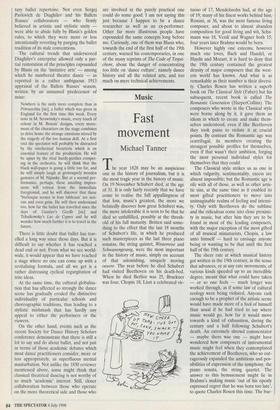Dance
Go to Blasis
Giannandrea Poesio
In 1828 the Italian dancer, ballet-master and dance theorist Carlo Blasis published in London The Code of Terpsichore, des- tined to become the bible of classical bal- let. The local intelligentsia, however, did not share the enthusiasm expressed by the dance community for the publication of the tome. In reviewing the book's second and more popular 1830 edition, an anonymous journalist wrote in The Spectator: This is a bulky volume on the art of dancing: its pages are in number 548, of the octavo size; it is accompanied both by plates and by music. The sight of such publication informs us where we are in the history of the world: they [sic] imply a degree of luxury which we would fain to consider only compatible with an extreme state of civilisation. It is certainly a proof of the overflow of all the blessings of life: there can be no mendicity societies when so many hundred pounds are risked on the sale of The Code of Terpsichore. Conceive the appearance of such a work in Philadelphia or at Port Jackson. Poor Mr Blasis would cut his sixty-six kinds of entrechats to a public intent solely upon shearing sheep and retail- ing soap.
No dance historian seems to have taken such an adverse, unflattering comment into account, though.
Blasis has always enjoyed a grand posthumous reputation that stems partly from the typically blinkered, celebratory `Well yeh I used to paint for myself but now I paint for Charles Saatchi: enthusiasm with which scholars approach the 'great masters' of the past and partly from a superficial reading of the man's principles. Yet this is not the right context to assess whether he was a pedantic old buffer or a true innovator. What is more interesting here is to evaluate how much has survived of his artistic legacy, 170 years later, and to what extent current classical theatrical dancing could benefit from both a revision and re-evaluation of his princi- ples.
Indeed, the man who compiled the list of the ideal dance teacher's prerequisites would be horrified at seeing that the 'art' of teaching ballet relies today on a prosaic market of diplomas, thriving under the umbrella of associations which claim to perpetuate artistically illustrious principles, alas in the form of artistically sterile syl- labuses. And he would probably be equally horrified at knowing that, in spite of his carefully devised advice to the possible bal- let student, hordes of gullible children sent by even more gullible parents — flock every year around 'qualified' teachers who have little knowledge of what performing is about — and then make loud noises of complaint when confronted by the unavoid- ably tough reality of ballet.
But what about the artistic expressive- ness he recommended in every possible pose or movement? Were he given the chance of watching a contemporary ballet performance, Blasis would be the first to frown at the lack of both that 'profound interpretation' and that 'geometrical purity' he advocated so strongly in his manuals.
It is true, however, that by the mid-19th century his technical and theoretical princi- ples had already been supplanted by a trendier display of gratuitous virtuoso feats. Evidence is to be found in the report of yet another anonymous contributor to The Spectator, who summarised the plot of the 1843 London performance of Giselle, star- ring Fanny Elssler, in the following way: Giselle falls a victim to her passion for pirou- etting. True, she dies, and becomes meta- morphosed into a *Hi', because her lover, who puts on the guise of a peasant, turns out to be a young Duke, who cannot marry her. But she would have not induced a young Duke to take the cottage opposite hers — as lovers always do in ballets — and assume the guise of a swain, consisting of elastic integu- ments so tight that it would seem equally impossible to put them on or off, unless she had been addicted to dancing, and in the habit of tripping about on tiptoes and twirling round like a top till her brain turned too.
As can be seen, the artistic, classical expressiveness of Blasis's 'ideal beauty' had already gone to the dogs long before our gloomy days. Even the ballet master's rec- ommendations about the way the Aris- totelian Unities had to be constantly applied to a ballet plot were soon to be dis- regarded in favour of those bemusing dra- matic absurdities and geographical incongruities that fill most of the 19th-cen- tury ballet repertoire. Not even Sergej Pavlovich de Diaghilev and his Ballets Russes' collaborators — who firmly believed in artistic and stylistic unity were able to abide fully by Blasis's golden rules, to which they were more or less intentionally reverting by purging the ballet tradition of its stale conventions.
The cultural trends that underscored Diaghilev's enterprise allowed only a par- tial restoration of the principles expounded by Blasis on the 'imitative arts' — among which he numbered theatre dance — as reported in a rather ambiguous 1913 appraisal of the Ballets Russes' season, written by an unnamed predecessor of mine: Nowhere is the unity more complete than in Petrouschka [sic], a ballet which was given in England for the first time this week. Every note in M. Strawinsky's music, every touch of colour in M. Benois' designs, every move- ment of the characters on the stage combines to drive home the strange emotions stirred by the tragedy of the too human doll. At a first visit the spectator will probably be distracted by the intellectual bizarrerie which is an essential feature of the production. He will be upset by the rival hurdy-gurdies compet- ing in the orchestra, he will think that the black wall-paper is going a little too far, and he will simply laugh at grotesquely wooden gestures of M. Nijinsky. But at a second per- formance, perhaps, these assailing impres- sions will retreat from the immediate foreground, and he will discover that these `burlesque scenes in four tableaux' are seri- ous and even grim. He will then understand too, how far the ballet has travelled since the days of Gautier's Gizelle [sic] and Tchaikowsky's Lac de Cygnes and he will wonder how much further it is to travel in the future.
There is little doubt that ballet has trav- elled a long way since those days. But it is difficult to say whether it has reached a dead end or not. From what we see world- wide, it would appear that we have reached a stage where no one can come up with a revitalising formula, and all we get is a rather distressing cyclical regurgitation of trite ideas.
At the same time, the cultural globalisa- tion that has affected so strongly the dance scene has gradually eroded the distinctive individuality of particular schools and choreographic traditions, thus leading to a stylistic mishmash that has hardly any appeal to either the performers or the viewers.
On the other hand, events such as the recent Society for Dance History Scholars conference demonstrate that there is still a lot to say and do about ballet, and not just in terms of those academic debates which most dance practitioners consider, more or less appropriately, as superfluous mental masturbation. Not unlike the 1830 reviewer mentioned above, some might think that classical theatrical dancing is not worthy of so much 'academic' interest. Still, closer collaboration between those who operate on the more theoretical side and those who are involved in the purely practical one could do some good. I am not saying this just because I happen to be a dance researcher as well as an ex-performer. Other far more illustrious people have expounded the same concepts long before me. Curiously, one of them was Blasis who, towards the end of the first half of the 19th century, warned his contemporaries, in one of the many reprints of The Code of Terpsi- chore, about the danger of concentrating too little on 'dance culture', namely dance history and all the related arts, and too much on mere technical achievements.















































































































 Previous page
Previous page